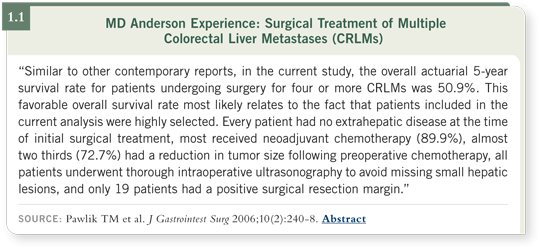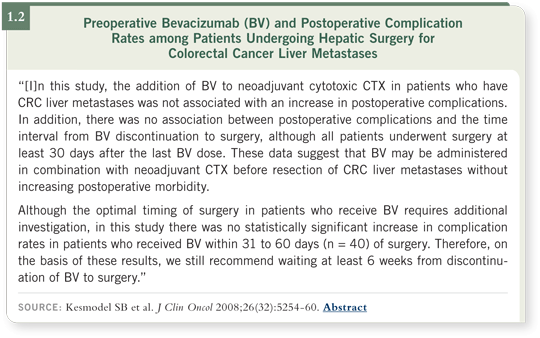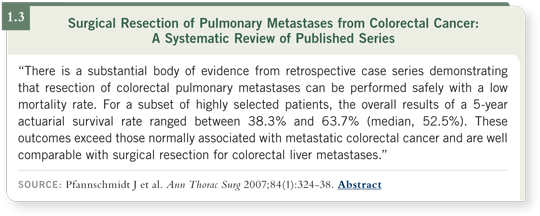
 |
|||||||

| Tracks 1-10 | ||||||||||||||||||||||
|
Select Excerpts from the Interview
Track 1
![]() DR LOVE: Can you discuss the evolution in the treatment of liver-only
colorectal metastases?
DR LOVE: Can you discuss the evolution in the treatment of liver-only
colorectal metastases?
![]() DR CURLEY: In the late 1980s and early 1990s, patients who presented with
synchronous primary and metastatic disease, had more than three or four liver
metastases or had small-volume extrahepatic disease were considered incurable.
Now we have data for each of those subsets that show an opportunity for
long-term survival.
DR CURLEY: In the late 1980s and early 1990s, patients who presented with
synchronous primary and metastatic disease, had more than three or four liver
metastases or had small-volume extrahepatic disease were considered incurable.
Now we have data for each of those subsets that show an opportunity for
long-term survival.
For example, a number of groups have examined the issue of curative surgery for patients with more than four hepatic metastases, including Rene Adam at the Paul Brousse Hospital (Adam 2003). With surgery alone, these patients have a five-year survival rate in the range of 20 to 25 percent.
However, if we add adjuvant or neoadjuvant chemotherapy, their five-year survival rate at MD Anderson is 51 percent (Pawlik 2006; [1.1]). Approximately 20 percent are alive and disease free at five years, while the other 30 percent are alive with disease. Essentially, we have changed the landscape for these patients in that they are living longer.

Track 3
![]() DR LOVE: What is your approach for a patient who presents with primary
colorectal cancer and potentially resectable metastatic disease?
DR LOVE: What is your approach for a patient who presents with primary
colorectal cancer and potentially resectable metastatic disease?
![]() DR CURLEY: If the patient presents with an asymptomatic or minimally
symptomatic primary tumor, we frequently begin with three months of
systemic chemotherapy and then we restage the disease. At MD Anderson,
our data from the past five years showed that in 24 percent of these patients
the primary tumor essentially disappeared. We still resect the primary
tumor. Surgery reveals that although some patients are pathologic complete
responders, an even larger number have remaining microscopic disease. We
resect the liver metastases because we believe it will impact survival.
DR CURLEY: If the patient presents with an asymptomatic or minimally
symptomatic primary tumor, we frequently begin with three months of
systemic chemotherapy and then we restage the disease. At MD Anderson,
our data from the past five years showed that in 24 percent of these patients
the primary tumor essentially disappeared. We still resect the primary
tumor. Surgery reveals that although some patients are pathologic complete
responders, an even larger number have remaining microscopic disease. We
resect the liver metastases because we believe it will impact survival.
If the patient had a symptomatic primary tumor, in most cases I would resect the primary and stage the liver disease with intraoperative ultrasonography. Then I would administer systemic chemotherapy and resect the metastases later.
![]() DR LOVE: What if the liver metastases disappear on imaging after treatment?
DR LOVE: What if the liver metastases disappear on imaging after treatment?
![]() DR CURLEY: Data have demonstrated that microscopic disease was still present
in 85 percent of such cases (Benoist 2006), which tells us that even though
we downsize the tumor, we still need to examine the area where the tumor
existed and try to include that in our resection.
DR CURLEY: Data have demonstrated that microscopic disease was still present
in 85 percent of such cases (Benoist 2006), which tells us that even though
we downsize the tumor, we still need to examine the area where the tumor
existed and try to include that in our resection.
![]() DR LOVE: Do you make exceptions for which you still resect the metastatic
disease before using chemotherapy?
DR LOVE: Do you make exceptions for which you still resect the metastatic
disease before using chemotherapy?
![]() DR CURLEY: Not all tumors respond to systemic chemotherapy, and some may
progress, so I always ask myself whether the tumor would become unresectable
if the disease progressed. In those cases, I have performed the liver resection
first, followed by systemic chemotherapy and finally resection of the primary
tumor.
DR CURLEY: Not all tumors respond to systemic chemotherapy, and some may
progress, so I always ask myself whether the tumor would become unresectable
if the disease progressed. In those cases, I have performed the liver resection
first, followed by systemic chemotherapy and finally resection of the primary
tumor.
![]() DR LOVE: Do you ever resect the primary tumor and the liver metastases in
the same procedure?
DR LOVE: Do you ever resect the primary tumor and the liver metastases in
the same procedure?
![]() DR CURLEY: It depends on the volume of the liver resection. The liver needs
a lot of protein and energy to heal itself. We and others have shown that we
can do both if we are not performing a major resection. However, when
removing 75 or 80 percent of the liver, it would be too risky to perform the
two procedures at once.
DR CURLEY: It depends on the volume of the liver resection. The liver needs
a lot of protein and energy to heal itself. We and others have shown that we
can do both if we are not performing a major resection. However, when
removing 75 or 80 percent of the liver, it would be too risky to perform the
two procedures at once.
Track 6
![]() DR LOVE: How many weeks do you wait between the use of bevacizumab
and surgery, when feasible, and have you run into problems with
wound healing?
DR LOVE: How many weeks do you wait between the use of bevacizumab
and surgery, when feasible, and have you run into problems with
wound healing?
![]() DR CURLEY: We wait six weeks (Kesmodel 2008; [1.2]). Recently, we
presented data at the Society of Surgical Oncology meeting showing that
when we discontinued bevacizumab six weeks before surgery, the complication
rate was not increased after major liver resections. We examined not only
wound healing but also liver regeneration because of the experimental data
suggesting that bevacizumab impairs regeneration (Zorzi 2008).
DR CURLEY: We wait six weeks (Kesmodel 2008; [1.2]). Recently, we
presented data at the Society of Surgical Oncology meeting showing that
when we discontinued bevacizumab six weeks before surgery, the complication
rate was not increased after major liver resections. We examined not only
wound healing but also liver regeneration because of the experimental data
suggesting that bevacizumab impairs regeneration (Zorzi 2008).
![]() DR LOVE: Have you observed problems with bowel perforation in patients
who received bevacizumab?
DR LOVE: Have you observed problems with bowel perforation in patients
who received bevacizumab?
![]() DR CURLEY: Among the patients whom we treated with FOLFOX/bevacizumab
for Stage IV disease with an intact primary tumor, a few experienced
perforation. We always warn patients to report certain symptoms right away.
We are then forced to operate on these patients at an inopportune time,
because they’ve received bevacizumab.
DR CURLEY: Among the patients whom we treated with FOLFOX/bevacizumab
for Stage IV disease with an intact primary tumor, a few experienced
perforation. We always warn patients to report certain symptoms right away.
We are then forced to operate on these patients at an inopportune time,
because they’ve received bevacizumab.
Track 7
![]() DR LOVE: Beyond hepatic metastases, what other sites may be considered
surgically resectable?
DR LOVE: Beyond hepatic metastases, what other sites may be considered
surgically resectable?
![]() DR CURLEY: Frequently patients with liver metastases also have metastases
in the lymph nodes in the porta hepatis, and a lymphadenectomy in those
cases has potential for survival benefit. More commonly, we see patients who
present with either synchronous or metachronous liver and lung metastases.
They may have resectable liver metastases, or they may already have undergone
liver resection and then present with one or two lung metastases that
are technically resectable. We and several others have data that show surgical treatment of those lung metastases can provide a long-term survival benefit for
a subset of patients (Pfannschmidt 2007; [1.3]).
DR CURLEY: Frequently patients with liver metastases also have metastases
in the lymph nodes in the porta hepatis, and a lymphadenectomy in those
cases has potential for survival benefit. More commonly, we see patients who
present with either synchronous or metachronous liver and lung metastases.
They may have resectable liver metastases, or they may already have undergone
liver resection and then present with one or two lung metastases that
are technically resectable. We and several others have data that show surgical treatment of those lung metastases can provide a long-term survival benefit for
a subset of patients (Pfannschmidt 2007; [1.3]).


| Table of Contents | Top of Page |
| Terms of Use and General Disclaimer | Privacy Policy Copyright © 2008 Research To Practice. All Rights Reserved. |